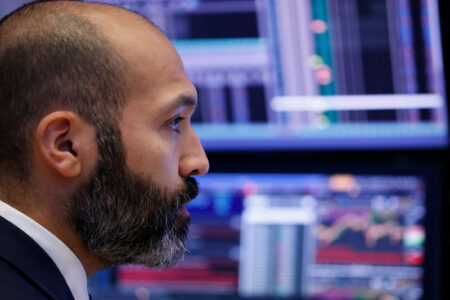Once a Silicon Valley leader, Intel has been a staple of the computer chip-making business for decades. In the last several years, it has fallen from grace, failing to jump on the AI train in time.
For decades, Intel led in chip design and manufacturing. A series of missed opportunities over the years has contributed to its current financial challenges.
When The Wall Street Journal dropped the news on Friday that Qualcomm had approached Intel with a potential takeover, tech forums were abuzz—and for good reason for the shake-up.
A rescue for Intel is bound up with debates about the US’s shifting role in the world’s chip industry and the battle for dominance in the era of accelerated computing.
Intel has been trying to correct its course for years. In 2021, it brought back CEO Pat Gelsinger, a former VMware CEO and a longtime Intel executive, to revive its leadership status in the chips industry. It has recently benefited from CHIPS and Science Act funding to create more microchip manufacturing capabilities in Arizona. And it made a series of acquisitions to catch up on developing more advanced architectures and profit from the AI boom.
Intel’s American manufacturing efforts are a big gamble for the company’s future. Each new fab can take billions of dollars and three to four years to complete, time which Intel may not have on its side. Even if Qualcomm acquired Intel, it’s unclear what it would do with its manufacturing operations.
While Intel has built Ohio factories, major chip designers have not publicly signed up.
“They just dropped the ball there, and until now, they’re trying to build the foundry business, but they haven’t even proven that they can make stuff for themselves yet,” said Stacy Rasgon, a senior analyst at Bernstein Research.
A series of unfortunate events
Intel was instrumental to the personal computer boom in the 1990s, designing and manufacturing cutting-edge microprocessors. With its x86 CPUs (central processing units), Intel drove rivals such as AMD out of the market.
Because of its focus on PCs, Intel chose not to capitalize on mobile chip growth in the 2000s — a big mistake because of the iPhone boom.
In a 2013 interview with The Atlantic, former Intel CEO Paul Otellini expressed regret for passing up a deal with Apple to design and manufacture chips for the iPhone before the smartphone was introduced. The two companies could not reach an agreement because Intel’s forecasts said that volume would not make up for the cost.
“We ended up not winning it or passing on it, depending on how you want to view it. And the world would have been a lot different if we’d done it,” Otellini told The Atlantic. “And in hindsight, the forecasted cost was wrong, and the volume was 100x what anyone thought.”
Another opportunity came along when OpenAI approached Intel for an investment. OpenAI wanted to reduce its reliance on Nvidia’s chips for its AI and build its own infrastructure. The deal fell through, and according to a Reuters report, Intel’s leadership did not think generative AI models would make it to the market soon. That bet would later come to bite back Intel, and now OpenAI has billions in backing from Microsoft.
Intel bought the deep learning startup Nervana Systems in 2016 to invest in AI. The chipmaker soon ceased operations at Nervana and placed its bets on Israeli startup Habana Labs, which it acquired for $2 billion in 2019. Habana helped launch Intel’s next-generation Gaudi AI chip for businesses this year.
Intel’s lack of GPUs
While Intel focused on CPUs, competitors like chip designers AMD and Nvidia hedged their bets on GPUs, or graphics processing units, that could assist with accelerated computing, a critical need for training AI.
“They didn’t really have a GPU product road map,” Rasgon said.
Intel had a stand-alone graphics chip called Larrabee in beta development. However, the project was canceled in 2009 and converted to a software development platform after failing to hit performance targets.
“Nvidia’s dominance didn’t come from luck. It came from vision and execution. Which Intel lacked,” tweeted Bryan Catanzaro, vice president of applied deep learning research at Nvidia, who previously worked at Intel as an intern on the Larrabee project.
The CPUs that made Intel big now have presented what Logan Purk, senior analyst at Edward Jones, called “the inventor’s dilemma,” when newer technology replaces established incumbents.
“I think management just rested on their laurels, so to speak, and there wasn’t a strong competitor nipping at their heels to force them to continue to push that innovation,” Purk said.
Manufacturing delays
Intel’s customers and rivals took their silicon business overseas to cut costs. Companies like AMD and Nvidia decided to leapfrog on chip designs while outsourcing manufacturing.
Intel’s manufacturing capabilities fell behind its customer demands. It ran into delays for its chips while TSMC was shipping chips for Apple, AMD, and Qualcomm. In 2020, Intel announced a delay to its 7-nanometer chips due to a “defect mode” that would have been key for its next generation of chips. Samsung and TSMC soon announced more advanced manufacturing capabilities, fitting more transistors in a processor and leaving Intel behind once again.
After using Intel’s chips for 15 years on its Macbooks, Apple debuted its in-house chip design with the M1 in 2020 and contracted out manufacturing to TSMC.
Intel is now placing its bets on the 18A chip and its Xeon data center chips. Gelsinger’s latest announcements point to creating an independent subsidiary for Intel’s foundries, allowing more independence to obtain and borrow capital.
A potential Qualcomm merger
A cash rescue could be coming. Mobile chipmaker Qualcomm approached Intel to acquire its chip-designing business and, later, a merger deal, Reuters and the Journal reported, respectively. Apollo Global Management has also offered an “equity-like” investment of up to $5 billion, Bloomberg reported.
“If Intel was to be acquired by like a Qualcomm or a Broadcom, or any of these other big chip companies, that would be one of the biggest deals that has ever occurred in the chip space. Like monumental,” said Dan Morgan, a senior trust portfolio manager at Synovus.
The merger could also reinvigorate the Biden administration’s efforts to position the US as a global chip manufacturing hub and create a competitor capable of challenging Nvidia’s monopoly in the AI chip market, Morgan said.
Though it would help Qualcomm diversify its products, the takeover would be a difficult bridge between the two companies and would not patch up Intel’s weaknesses, analysts said.
“Now, you’re buying their PCs and servers at present, but you’re buying all the issues in their foundry business. Why would you want to get involved in that? That is a huge undertaking,” said Morgan.
Read the full article here
















